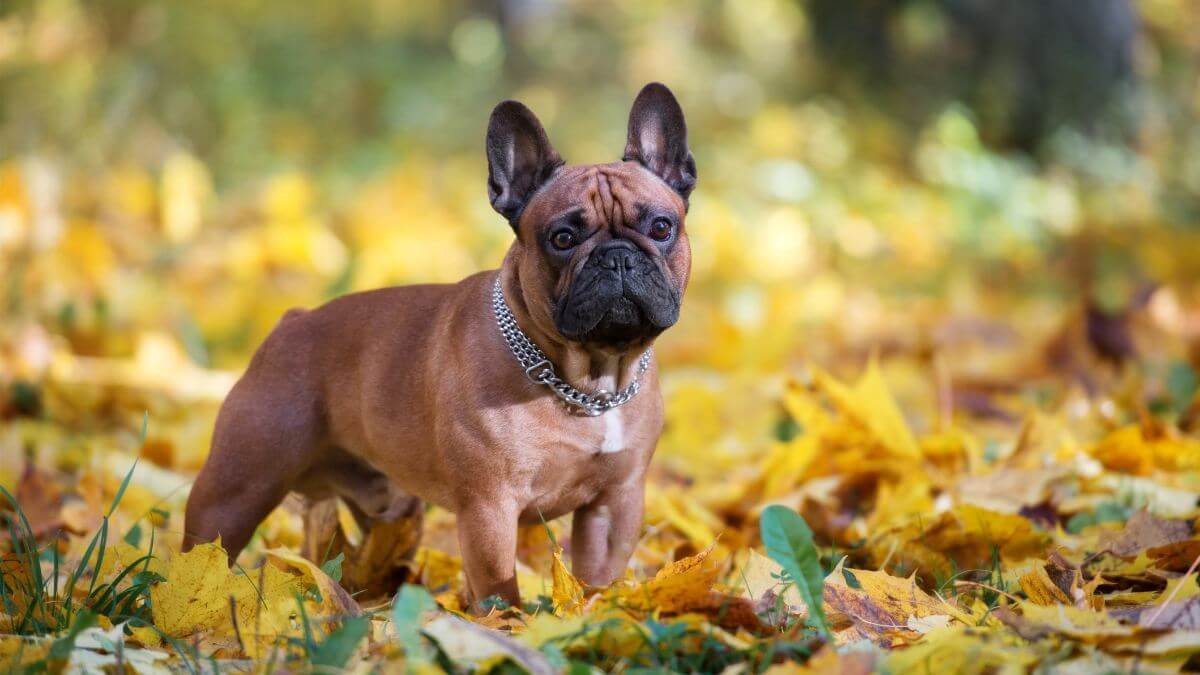
Home » Judging the French Bulldog: Finding the Diamond in the Rough!

This article was originally published in Showsight Magazine, March 2013 issue.
The French Bulldog is a small, cobby, square dog with a large head, bat ears, and an off-level topline. Right? NO!
Though this generic statement is misleading and largely false, it often appears that this “CliffNotes” version of the Frenchie Standard is at times rewarded in the show ring. This article will hopefully help explain some of the most important points of the Frenchie silhouette that are often overlooked, and offer some common-sense suggestions on evaluating our breed. Above all, please remember that this is strictly our opinion as breeders and exhibitors of this breed for over 30 years.
The first paragraph of the Standard describes the Frenchie as an “active, intelligent, muscular dog of heavy bone, smooth coat, compactly built, and of medium or small structure.” Two items of note in this description are the “compactly built” and the “medium or small structure.” While at first, you might think that this description implies a square or overly cobby dog, when you consider these phrases within the context of the history of the French Bulldog, it doesn’t.
These terms can be traced back to early standards when the Frenchie was a much longer-backed dog than what we typically find in the ring today. “Compactly built” means short, yet still having some length of loin, meaning that the correct French Bulldog will still have some overall length. We must be careful not to reward overly short, “cobby” dogs. Without a correct length of loin, it is not possible to have a correct topline or the pear shape which is characteristic of the breed. Compact also does not mean square, but more on that later.
In fact, the only thing square about the French Bulldog is the head, which is “large and square” when viewed from the front. Large is in relation to the size of the dog, and a correct square head is more important than mere size. We unfortunately see large, round-headed Frenchies, or dogs with ears pointing straight up to heaven rewarded in the show ring. Remember that the head is square, with bat ears set at 11 and 1 on the dial. The ears are expressive and need not be carried forward at all times.
Similarly, “medium or small structure,” in our opinion, refers to the French Bulldog relative to its English counterpart, the Bulldog. Being of medium or small structure does not make the Frenchie a “toy” breed and certainly not a toy Bulldog. As a breeder, my personal preference is for a dog to weigh around 23-27 lbs. and a bitch to be 20-26 lbs. However, as a judge, I have no issue whatsoever in rewarding a 28-lb. dog or bitch that is in correct weight, any more than in rewarding a 22-lb. dog. Remember that “over 28 pounds is a disqualification,” but the Standard does not give us a lower limit. However, I would not reward an oversized dog that is exhibited in very poor weight so it will weigh in.
The Standard does state under “Substance: Muscular, heavy bone.” It is up to you as judge to determine correct substance for the size of the dog, keeping in mind that they are neither toys nor “little Bulldogs.”
From a breeder’s perspective, the French Bulldog topline is probably the single most difficult aspect of the Standard to breed correctly. The Frenchie Standard states that the “back is a roach back with a slight fall close behind the shoulders; strong and short, broad at the shoulders and narrowing at the loins.” The second part of this sentence describes the characteristic Frenchie “pear” body shape; the first half describes the topline. The term “roach back” is ambiguous and has been subject to much discussion within Frenchie circles, and so it is open to a judge’s interpretation. Again, help can come from the Frenchie’s ancestor, the Bulldog, for insight. The Bulldog standard gives a very detailed description of the Bulldog roach: “Topline – There should be a slight fall in the back, close behind the shoulders (its lowest part), whence the spine should rise to the loins (the top of which should be higher than the top of the shoulders), thence curving again more suddenly to the tail, forming an arch (a very distinctive feature of the breed), termed ‘roach back’ or, more correctly, ‘wheel-back.’”
The 1926 book The French Bulldog, as published jointly by the French Bull Dog Club of America and the French Bulldog Club of New England, states: a “roach back” as explained in the standard of the English Bulldog is equally applicable to the French Bulldog. We believe that this statement is as valid today as when it was written almost a century ago.
What you determine in the ring to be a “roach back” is entirely at your discretion, but this is the guideline I use in judging a correct French Bulldog topline.
The Frenchie Standard further states, “The chest is broad, deep, and full; well ribbed with the belly tucked up.” Remember that the tuck-up should somewhat follow the topline and that a correct topline will more often than not exhibit the correct tail set, “hung low… carried low in repose.” A high tail set will often be indicative of an incorrect level topline. Remember that a straight topline, high in the rear, is not a roach.
Another area of difficulty is that of proportions. The Standard states, “Proportion – Distance from withers to ground in good relation to distance from withers to onset of tail, so that the animal appears compact, well balanced, and in good proportion.”
The key word in this description is “balance.” The Standard gives no specific body proportions for the Frenchie, only that it should appear compact, well balanced, and in good proportions. Notice that the length stated in the Standard does not include the forechest or the croup. This means that even if the length stated were equal to the height at the withers, the correct Frenchie will still appear longer than tall.
The photographs shown are of finished dogs, some of which are Group, BIS, and National Specialty winners. I believe that they are all balanced and of “good proportions.”
As an exercise, I drew a rectangle from the point of the shoulder to the point of the rump (Ischial tuberosity) to designate the length, and from the withers to the ground to designate the height. I then measured the photos to determine an approximate length-to-height ratio.
Where you actually measure makes a large difference, so all the ratios are approximate and only for illustration purposes. Of the animals shown, it was interesting to find that the shortest dog (Figure 2) had a length-to-height ratio of approximately 1.1 to 1, thus being about 10% longer than tall, while most of the other dogs were 13 to 15% longer than tall. Notice that all of these dogs have correct toplines with correct low tailsets.
I then took the photo of the 8-year-old bitch in Figure 1, who is 13% longer than tall, and digitally shortened her to a nearly square length-to-height ratio for illustration purposes (Figure 1A). You can see that the altered photograph now appears overly short, unbalanced, and poorly proportioned.
Since our Standard does not give us specific numbers, we are each at our own discretion to decide what are “good proportions.” I firmly believe, however, that the shortest dog in the ring is not always the best Frenchie. A correct back length not only gives correct toplines but also allows for a correct, freer gait, a correct tailset, and an overall healthier dog.
With some of the ambiguities in the Standard, a wide range of correct and incorrect dogs, and the large number of entries, the French Bulldog is probably one of the most challenging breeds to judge. However, if you clearly remember the correct silhouette—which includes correct size, topline, and proportions—you can quickly eliminate the incorrect dogs and refrain from rewarding the generic Frenchie.